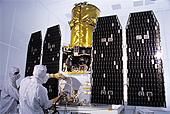
Home - Search - Browse - Alphabetic Index: 0- 1- 2- 3- 4- 5- 6- 7- 8- 9
A- B- C- D- E- F- G- H- I- J- K- L- M- N- O- P- Q- R- S- T- U- V- W- X- Y- Z
Galex
 Galex |
Status: Operational 2003. First Launch: 2003-04-28. Last Launch: 2003-04-28. Number: 1 . Gross mass: 280 kg (610 lb).
Such observations would provide data how galaxies, the basic structures of our Universe, evolve and change. Additionally, GALEX would probe the causes of star formation during a period when most of the stars and elements we see today had their origins. Led by the California Institute of Technology, GALEX was to conduct several first-of-a-kind sky surveys, including an extra-galactic ultraviolet all-sky survey.
- MISSION NAME: Galaxy Evolution Explorer (GALEX), a NASA small explorer class mission.
- OBJECTIVE: To map the history and evolution of the Universe, 80 percent of the way back to the Big Bang. GALEX aims to answer the questions: What was the history of star formation in the Universe? What do nearby galaxies look like in ultraviolet light? When and where did the stars and elements we see today have their origins?
- MISSION DURATION: 29 months.
- ORBIT: 690 kilometers (428 miles), 29 degree inclination to the equator.
- SATELLITE MASS: 280 kilograms.
- TELESCOPE: f/6.0 Richey-Chretien design, 50 centimeter diameter primary mirror, 22 centimeter diameter secondary mirror.
- DETECTORS: Two 65 millimeter diameter, microchannel plate detectors. Far ultraviolet sensitive to light with wavelengths 135 to 175 nanometers. Near ultraviolet sensitive to light with wavelengths 175 to 280 nanometers.
- OBSERVING TIMELINE: Dayside of the Earth: no science observations, solar panels aligned to face the Sun. Twilight: slew to science target. Night: science data collection while spacecraft was in Earth's shadow.
- DATA PRODUCTS: Circular images of the sky with 1.2 degree diameter and 5 arcsecond resolution in two ultraviolet light bands. Spectra with 10 to 20 Angstrom resolution of all objects in the field of view obtained using a prism in the light path.
- TELEMETRY SYSTEM: X-band science downlink had 25 Megabits per second transmission. S-band command and housekeeping data link, 2 Megabits per second transmission.
- GROUND STATIONS: South Point, Hawaii, and Dongara, Australia. Tracking and Data Relay Satellite (TDRS) communications system capable.
- SOLAR ARRAYS: Fixed, Gallium Arsenide solar cells with total area of 3 square meters.
- POWER SUPPLY: Orbit average of 290 watts.
- CONSUMABLES: No consumable fuel needed on orbit.
- SPACECRAFT ATTITUDE CONTROL: 3-axis stabilized. Two gyroscope systems; a hemispherical resonating gyroscope and a ring laser gyroscope. Pointing stability from four reaction wheels and magnetic torque bars and coil. Pointing direction determined using a Sun sensor and a star tracker.
- SPACECRAFT BUS: Built by Orbital based on the OrbView4 satellite design.
- PRINCIPAL INVESTIGATOR: Professor Chris Martin, California Institute of Technology.
- PROJECT MANAGER: Jim Fanson, Jet Propulsion Laboratory.
- MISSION OPERATIONS MANAGER: Kerry Erickson, Jet Propulsion Laboratory.
- MAJOR CONTRACTORS/CONTRIBUTORS: California Institute of Technology; Jet Propulsion Laboratory; Orbital; Johns Hopkins University; Laboratoire d'Astronomie Spatial, France; Yonsei University, South Korea; University of California, Berkeley; Goddard Space Flight Center; Kennedy Space Center; Space Telescope Science Institute
NASA NSSDC Master Catalog Description
The Galaxy Evolution Explorer (GALEX) is an orbiting space ultraviolet telescope, which explores the origin and evolution of galaxies, and the origins of stars and heavy elements over the redshift range of z between 0 and 2. GALEX will conduct an all-sky imaging survey, a deep imaging survey, and a survey of 200 galaxies nearest to the Milky Way Galaxy. As well, GALEX will perform three spectroscopic surveys over the 135-300 nanometer band. GALEX has a planned 29 month mission, and is a part of the Small Explorers (SMEX) program.
The spacecraft will be three-axis stabilized, with power coming from four fixed solar panels. The spacecraft bus is from Orbital Sciences Corporation based on OrbView 4. The telescope is a 50-cm Modified Ritchey-Chretien with a rotating grism. GALEX uses the first ever UV light dichroic beam-splitter flown in space to direct photons to the Near UV (175-280 nanometers) and Far UV (135-174 nanometers) microchannel plate detectors. Each of the two detectors has a 65 millimeter diameter. The target orbit is 670 km circular and inclined at 28.5 degrees to the equator.
More at: Galex.
Family: Astronomy, Ultraviolet astronomy satellite. Country: USA. Launch Vehicles: Pegasus, Pegasus XL. Launch Sites: Mayport DZ. Agency: JPL, NASA, OSC. Bibliography: 2, 6511, 12468.
 | Galex Credit: Manufacturer Image |
2003 April 28 - . 12:00 GMT - . Launch Site: Cape Canaveral. Launch Complex: Mayport DZ. Launch Pad: 29.0 N x 78.5 W. Launch Platform: L-1011. LV Family: Pegasus. Launch Vehicle: Pegasus XL.
- Galex - .
Mass: 280 kg (610 lb). Nation: USA.
Agency: NASA.
Manufacturer: OSC.
Class: Astronomy.
Type: Ultraviolet astronomy satellite. Spacecraft Bus: LEOStar-2.
Spacecraft: Galex.
Duration: 3,710.00 days. USAF Sat Cat: 27783 . COSPAR: 2003-017A. Apogee: 699 km (434 mi). Perigee: 694 km (431 mi). Inclination: 29.00 deg. Period: 98.70 min.
Ultraviolet space telescope. Much delayed launch (from January 19, May 19, July 16, 21 and 30, August 14 and October 17, 2002; January 27, March 25 and 30, April 15 and 26 2003). It was finally switched off on 28 June 2013, following an extra tenth year of observing funded by Caltech. Air dropped in Mayport DZ.
Back to top of page
Home - Search - Browse - Alphabetic Index: 0- 1- 2- 3- 4- 5- 6- 7- 8- 9
A- B- C- D- E- F- G- H- I- J- K- L- M- N- O- P- Q- R- S- T- U- V- W- X- Y- Z
© 1997-2019 Mark Wade - Contact
© / Conditions for Use